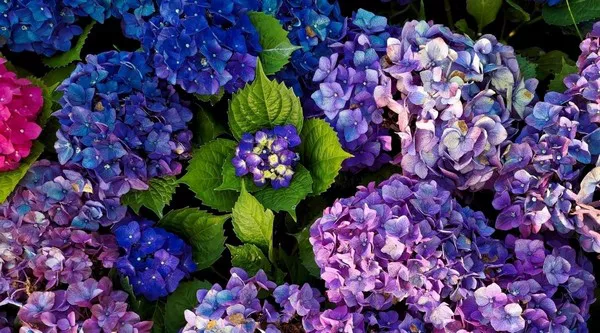Hydrangeas are beloved ornamental plants known for their lush, beautiful blooms. These versatile shrubs come in various colors, but one of the most coveted shades is blue. Achieving that perfect shade of blue on your hydrangea flowers can be a rewarding gardening challenge. In this guide, we will explore the intricacies of how to get blue flowers on hydrangea and help you create a vibrant and picturesque hydrangea garden.
1. Understanding Hydrangea Color Variability
Before we delve into the methods of turning your hydrangea flowers blue, it’s crucial to understand the factors influencing their color. Hydrangea flower color depends primarily on the pH level of the soil. This pH-induced color shift occurs due to the presence of aluminum ions in the soil, which are taken up by the plant’s roots. Blue hydrangea blooms are a result of low soil pH levels, typically below 5.5, which allows hydrangeas to absorb aluminum.
2. Choosing the Right Hydrangea Variety for Blue Blooms
Not all hydrangea varieties can turn blue, so selecting the right type is crucial. The most commonly known hydrangea species that can produce blue flowers are Hydrangea macrophylla, often referred to as “bigleaf” or “mophead” hydrangeas. These hydrangeas are known for their color-changing ability and are the go-to choice for achieving that stunning blue hue. Ensure you have the right hydrangea species in your garden to start your journey towards blue blooms.
3. Testing and Adjusting Soil pH for Blue Hydrangeas
To get those coveted blue hydrangea blossoms, you need to make your soil more acidic. Start by testing your soil’s pH level using a soil testing kit, readily available at garden centers. If your soil pH is above 5.5, you’ll need to lower it. This can be done by adding acidic amendments, such as sulfur or aluminum sulfate, to your soil. Be cautious and follow package instructions, as over-acidifying your soil can harm your hydrangeas.
When to Adjust Soil pH
Timing is essential when it comes to altering your soil’s pH for blue hydrangeas. The best time to adjust soil pH is in the late fall or early spring. This allows the amendments to work gradually and ensures that your hydrangeas will absorb the aluminum when they start developing buds for the upcoming season. It’s a patient gardener’s game, as results may not be immediate.
4. Maintaining Consistent Soil pH for Blue Hydrangeas
Maintaining a consistent soil pH level is crucial for the long-term success of blue hydrangeas. Regularly check the pH of your soil, especially if you notice the color of your hydrangea blooms shifting towards pink. You may need to reapply the acidic amendments to keep the pH in the desired range. Additionally, consider mulching your hydrangeas with pine needles or compost, as these can help maintain soil acidity.
5. Watering and Fertilizing Practices for Blue Hydrangeas
Proper watering and fertilizing techniques play a vital role in the health and color of your hydrangea blooms. Hydrangeas thrive in consistently moist, well-draining soil. To maintain the ideal soil moisture, water your hydrangeas deeply and consistently, ensuring that the soil doesn’t become too dry or too saturated.
When it comes to fertilization, avoid high-phosphorus fertilizers, as they can inhibit aluminum uptake by the plant. Instead, opt for a balanced or slightly acidic fertilizer with a higher percentage of potassium. This will promote healthy growth while supporting the color transition of your hydrangea blooms.
6. Pruning Strategies for Blue Hydrangeas
Pruning hydrangeas can significantly impact the quantity and quality of blooms. To encourage blue hydrangea flowers, it’s essential to understand the timing and methods of pruning. Hydrangea macrophylla varieties, which include the mophead and lacecap types, typically bloom on old wood. Therefore, it’s best to prune them immediately after they finish flowering in the late summer.
Remove dead or weak stems and only cut back healthy ones to shape the plant or control its size. Pruning at the wrong time can remove potential flower buds, affecting next year’s bloom.
7. Additional Tips for Enhancing Blue Hydrangea Color
Achieving that perfect shade of blue on your hydrangea flowers may require a few extra considerations. Here are some additional tips:
Use Rainwater: If your tap water is alkaline, consider collecting rainwater to hydrate your hydrangeas. Rainwater is naturally acidic and can help maintain the desired soil pH.
Aluminum Sulfate Application: You can apply aluminum sulfate as a liquid solution directly to the soil around your hydrangeas to boost their aluminum intake. Follow package instructions carefully.
Container Gardening: If you have difficulty controlling your garden’s soil pH, consider growing hydrangeas in containers. This allows you to have more precise control over the soil conditions.
Companion Plants: Planting hydrangeas along side acid-loving plants like azaleas and rhododendrons can help create a suitable soil environment for blue hydrangea blooms.
8. Common Mistakes to Avoid for Blue Hydrangeas
While striving for blue hydrangea flowers, it’s essential to avoid common pitfalls that can hinder your success:
Over-acidifying the Soil: Excessive use of acidic amendments can harm your hydrangeas and other plants in the vicinity. Always follow recommended application rates.
Inconsistent Soil pH: Neglecting to monitor and adjust soil pH regularly can result in the reversion of blue hydrangeas to pink or purple.
Pruning at the Wrong Time: Pruning your hydrangeas at the wrong time can remove potential flower buds and diminish your chances of blue blooms.
Inadequate Watering: Hydrangeas need consistent moisture. Failure to water them adequately can lead to stress, affecting flower color.
Conclusion
Achieving blue hydrangea blooms can be a delightful and rewarding endeavor for garden enthusiasts. By understanding the influence of soil pH, selecting the right hydrangea variety, and implementing proper care practices, you can transform your garden into a mesmerizing display of vibrant blue hydrangea blossoms. Remember that patience is key, as it may take some time and effort to reach that perfect shade of blue. With dedication and the right approach, your hydrangea garden will be a stunning testament to your gardening skills and passion for these beautiful plants.


